A Guide to Travelling the Silk Road
For centuries, the Silk Road has stirred the imagination. It was more than a trade route - it was a lifeline that carried stories, religions, spices, and silk across continents. Today, travelling the Silk Road is an invitation to retrace those footsteps, wander through bazaars that still buzz with colour, and walk paths that wind through mountains, deserts, and ancient cities.
If you’ve ever wondered where the Silk Road is, how long it is, or what it’s like to actually travel the Silk Road today, this guide will walk you through everything you need to know - with a little inspiration sprinkled in along the way.
Where is the Silk Road?
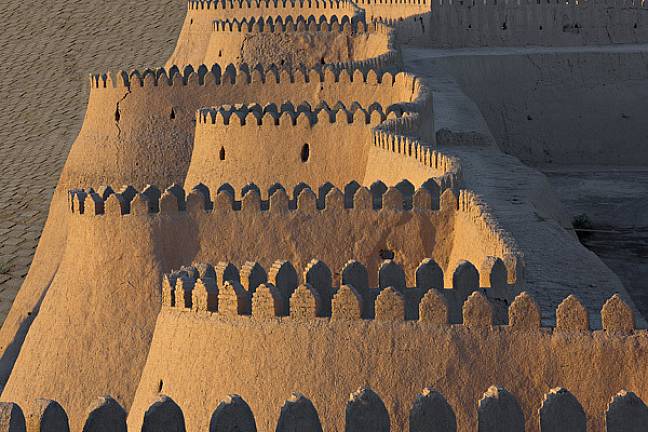
The Silk Road connects Central Asian countries like Kazakhstan, Kyrgyzstan, Tajikistan, Turkmenistan, and Uzbekistan. But the original Silk Road wasn’t just one path but a vast, shifting web of trade routes.
At its height, it linked Xi’an in China with Constantinople (modern-day Istanbul), stretching more than 6,500 kilometres. It wasn’t a single road carved in stone - it branched like a river, flowing through deserts, mountains, and cities that rose and fell with time.
Interestingly, the routes of the Silk Road carried not only silk but also jade, horses, spices, carpets, and even ideas. Buddhism spread eastwards along these trails, while mathematics and astronomy travelled west.
Some parts of the Silk Road still remain difficult to access today. Regions such as Iran, with their extraordinary Persian architecture and cultural treasures, are not currently considered safe to visit. Hopefully in time, these areas will open up again, allowing travellers to experience the full richness of the route.
How Long is the Silk Road?
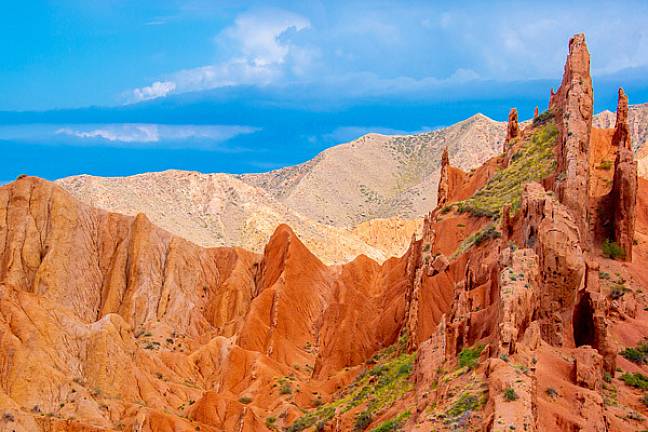
On a map, the Silk Road spans around 6,500 kilometres - from Xi’an to Istanbul - but the true journey is measured not just in miles, but in the time you choose to invest.
Traders from the past moved in caravans, sometimes taking months or even years to reach distant markets. Goods were passed caravan to caravan, like a relay, so most travellers didn’t go the entire way.
Today, you’ll often wonder: how long does it take to travel the Silk Road? It all comes down to what kind of journey you’re after. A focused tour, such as our Silk Road to Samarkand tour, could take two weeks or less, giving you plenty of leisure time to explore Uzbekistan’s cultural, architectural, and landscape treasures. Whilst on the tour, you’ll wander through the UNESCO-listed Ichan Kala in Khiva, explore the ruins of ancient fortresses in the Kyzylkum Desert, marvel at Bukhara’s covered bazaar, and soak up the grandeur of Samarkand’s ornate madrasas and domed mosques.
A more ambitious Silk Road journey - take our Five Stans Tour of Central Asia, for example - might take up to four weeks, weaving through Kyrgyzstan, Tajikistan, Kazakhstan, Uzbekistan, and Turkmenistan. During this tour, you’ll travel through desert ruins, hike in the Fann Mountains, marvel at Charyn Canyon, and even help set up a yurt or test your aim at archery. Along the way, you’ll stay in a mix of city hotels, guesthouses, and a yurt camp, all guided by expert local leaders.
For the truly adventurous, it’s possible to spend months wandering its many branches.
When is the Best Time to Travel the Silk Road?
The Silk Road spans mountains, deserts, and steppes, so the best time to visit varies. For most travellers, spring and autumn strike the best balance. As a general rule of thumb:
- Spring (April–June): Apricot blossoms in Uzbekistan, green meadows in Kyrgyzstan, and pleasant warmth in Iran.
- Summer (July–August): High mountain treks shine, but desert cities can hit 40°C.
- Autumn (September–October): Golden harvests, crisp air, and glowing light across Central Asia.
- Winter (November–March): Atmospheric, quieter, and very cold in places, but magical if you don’t mind snow.
Popular Silk Road Destinations
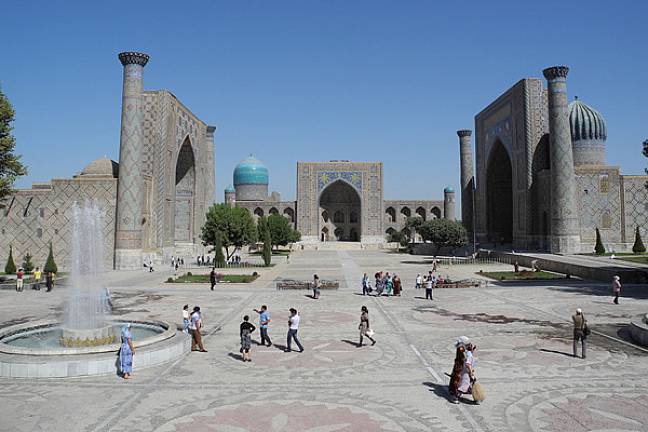
Samarkand, Uzbekistan
Samarkand in Uzbekistan is the jewel of the Silk Road. Samarkand’s Registan Square, framed by three vast madrasas tiled in blue and gold, is breathtaking. Wander into the Siab Bazaar for spices and pomegranates, or the Shah-i-Zinda necropolis with its kaleidoscope of turquoise tiles.
For an itinerary that showcases the very best of Uzbekistan’s treasures, consider our Silk Road Mountains & Monuments tour. It’s a journey through Samarkand, Bukhara, and beyond.
Khiva, Uzbekistan
Step through the mud-brick walls of Khiva’s Itchan Kala, and you’ll feel like you’ve entered a storybook. Minarets, domes, and carved wooden pillars transport you straight back to caravan times.
Kashgar, China
Once a vital Silk Road crossroads, Kashgar still hosts one of the world’s most vibrant bazaars. Sunday markets burst with livestock, spices, and textiles, echoing centuries of exchange.
The Fann Mountains, Tajikistan
An extension of the the Pamirs range in Tajikistan the Fann Mountains comprise over 100 peaks, several rising abover 5,000m. Travelling here feels like peeling back layers of time - Tajik shepherds still guide flocks to remote meadow uplands, and villages cling to traditions passed down for generations. The Fanns are particularly well known for the beautiful Seven Lakes area which is one of the scenic highlights of any silk Road journey.
Practical Details to Know When Travelling the Silk Road
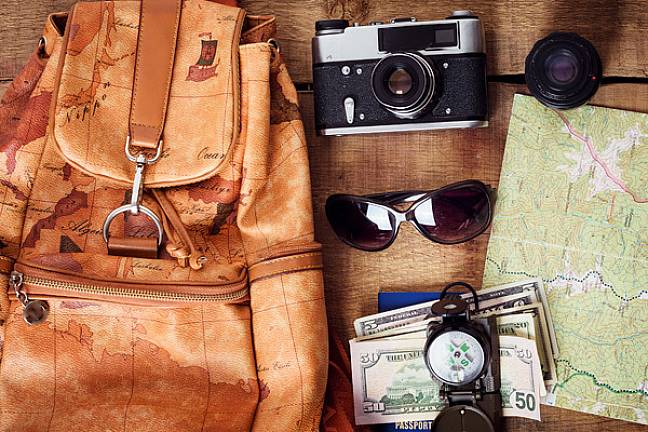
Visas and Entry Requirements
Visa policies across the Silk Road are more relaxed than they once were, but rules still vary.
Kyrgyzstan: Offers visa-free entry for up to 60 days to a wide range of travellers.
China: Entry requirements are more complex and often change. You’ll need to apply for a visa in advance, and it’s important to check with the Chinese Embassy well ahead of travel for the most up-to-date guidance.
Kazakhstan: Many visitors can now enter visa-free for short stays, making it one of the simpler gateways to Central Asia.
Tajikistan: Requires a visa (supporting travel documentation is required for the application).
Health and Safety on a Silk Road Tour
The Silk Road is generally safe and welcoming, but the environment can be demanding.
- Altitude: In Kyrgyzstan, Tajikistan, and western China, routes climb above 3,000m. Take it slow, stay hydrated, and allow time to acclimatise.
- Food & Water: Stick to bottled or filtered water. Street food is delicious, but choose stalls that are busy with locals.
- Healthcare: Major cities have decent facilities, but remote areas may not. Pack a first-aid kit and travel insurance that covers evacuation.
- Security: Central Asia has low crime rates, but petty theft is possible in busy markets.
Getting There and Around
The Silk Road route today is served by international airports such as Tashkent, Almaty and Xi’an. Once on the ground, you’ll find transport a blend of old and new.
- Trains: Uzbekistan’s Afrosiyob bullet train is sleek and efficient.
- Road Trips: Roads can be long and bumpy, but the scenery makes up for it.
- Walking the Silk Road: Trekking sections, especially in Kyrgyzstan and Tajikistan, is a deeply rewarding way to connect with its spirit. if you don't want to trek large sections than shorter day walks give a sense of the ancient trails.
Packing and Preparation
A Silk Road trip spans multiple climates. Essentials include:
- Breathable clothing for hot days.
- Warm layers for mountains.
- A scarf or shawl for modesty in religious sites.
- Sturdy shoes if you’re walking the Silk Road.
- A refillable water bottle with a filter.
Languages of the Silk Road
Travellers are often wowed by the blend of languages they hear. Russian was once the ‘lingua franca’ across much of Central Asia. It’s still spoken widely now, but its use is decreasing, especially among younger generations. Uzbek, Kyrgyz, and Kazakh are widely spoken in their respective countries.
Turkish is common in western stretches. English is increasing, especially among young people, but learning a few words - “rahmat” (thank you) in Uzbek, or “salaam” in Persian - can go a long way.
Food Along the Silk Road
One of the great joys of a Silk Road holiday is the food. Dishes have absorbed influences from China, Persia, Turkey, and beyond. Food isn’t just fuel here - it’s an act of sharing, and a window into culture.
- Plov (Pilaf): A hearty dish of rice, carrots, and lamb - the pride of Uzbekistan.
- Laghman: Hand-pulled noodles with vegetables and meat, popular in Xinjiang.
- Kebabs: Found everywhere, but each country does them differently.
- Bread: Round loaves, often decorated, form the centre of every table.
What to Expect on a Silk Road Trip
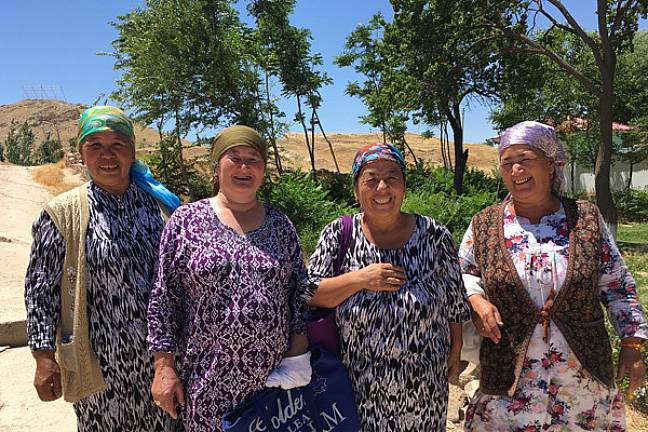
A Silk Road trip is not just about landscapes and monuments. It’s about immersion. One day, you might be sipping tea in a shaded caravanserai, listening to the murmur of traders’ voices echoing from centuries past, the next, you could be winding through a high-altitude pass where yaks graze beneath jagged peaks.
Hospitality
In Central Asia, hospitality is not a courtesy, it’s a way of life. Expect invitations to share tea, bread, and conversation with strangers who quickly feel like friends. It’s these encounters that often linger longest in your memory.
Culture and Heritage
The Silk Road is a tapestry woven with many threads. You’ll encounter Muslim madrasahs, Sufi shrines, Buddhist caves, and Soviet mosaics, often within a few hundred miles of each other. Each stop is like a page from a history book, but one you can step into and touch.
Landscapes
Imagine deserts that stretch like oceans of sand, mountains that glow pink at sunset, and steppes that roll endlessly beneath big skies. Walking the Silk Road in sections allows you to feel these shifts of geography underfoot, as well as giving you space for reflection.
Final Thoughts

Travelling the Silk Road is about more than visiting places. It’s about stepping into a living story, one written over centuries of exchange, encounter, and adventure. Whether your journey takes you through the turquoise domes of Samarkand, the high passes of the Fanns, or the bazaars of Kashgar, you’ll be part of a tradition that connects past and present.
For more inspiration, you can read our Interview with April about Travelling the Silk Road - a wonderful first-hand account that captures the spirit of adventure.
The Silk Road isn’t a line on a map; it’s a meeting place of cultures and landscapes. And whether you spend ten days or several weeks exploring, a Silk Road journey lingers long after you return home.
Frequently Asked Questions
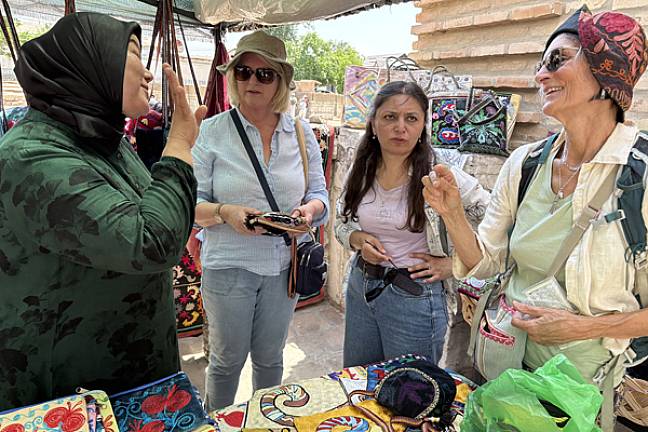
How should I manage money while travelling?
Managing money on a Silk Road trip is a little different from Europe or North America. Here’s what you need to know:
- US dollars are the most reliable currency for exchange.
- Always carry some local currency for smaller expenses like tips, snacks, or small souvenirs.
- ATMs are common in cities like Tashkent, Samarkand, and Almaty, but much harder to find in rural areas.
- Credit and debit cards work in hotels and some larger restaurants, but bazaars and smaller shops prefer cash
Is it safe for solo travellers?
Central Asia is one of the most hospitable parts of the world, and solo travellers are usually met with warmth and curiosity. Crime levels are low, particularly violent crime. That said, a few tips make sense:
- Stick to well-lit areas in cities after dark.
- Watch your belongings in crowded bazaars.
- Be cautious when accepting invitations - though genuine, they can sometimes be overwhelming.
- For women, travelling solo is generally safe, but modest dress and polite boundaries are important.
- Many solo travellers choose to join small group tours. This way, you keep the independence of travelling alone, but with the reassurance of a local guide and like-minded companions.
How should I dress while travelling here?
Dress codes vary, but modesty is the safest rule across the Silk Road. It’s not about blending in perfectly, but about showing respect for traditions - something always appreciated by local communities.
- In cities, lightweight clothes are great for hot days, but avoid anything too revealing.
- In mosques and religious sites, women should carry a scarf to cover their hair, and both men and women should wear long trousers or skirts.
- In the mountains, you should pack warm layers, as temperatures can drop sharply at night.
- For walking, you’ll need comfortable walking boots, quick-dry fabrics, and sun protection.
If you book a Silk Road holiday with Mountain Kingdoms, we'll provide a pre-trip dossier of essential information to help you prepare for your trip.
If you’re dreaming of exploring the Silk Road, Mountain Kingdoms has a handful of incredible tours which highlight the very best it has to offer, most of which begin in Uzbekistan. Led by our expert guides, our tours promise to reveal to you the very best that this beautiful country has to offer.
If you have any queries, simply email our friendly team at info@mountainkingdoms.com, or call our travel experts on 01453 844400 who'll be very happy to answer your questions.

All related blog posts:
An Interview with April: Travelling the Silk Road
Uzbekistan - Top 10 Travel Essentials
The Five Best Things to do in Uzbekistan

Mountain Kingdoms Operations Manager, Harry, created this blog based on his experience of visiting the Silk Road cities of Uzbekistan with Mountain Kingdoms. This is one of many trips Harry has completed since working with the company including several treks in Nepal, tours in Japan and Vietnam, a successful ascent of Kilimanjaro and, most recently, a wildlife recce to Ladakh in the Indian Himalaya.